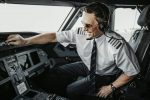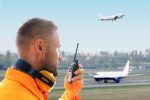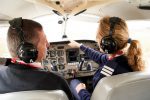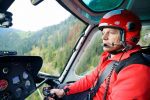Aviation is one of the most popular fields of study in our day and age because it can lead to an exciting and rewarding career in the air.
This section covers information about careers such as pilots, air traffic controllers, flight attendants, and more.

How to Become an Air Traffic Controller
An air traffic controller is responsible for directing traffic in the air. Working from the ground in various airports, they…

How to Become an Aircraft Mechanic
An aircraft mechanic is responsible for the routine maintenance, servicing, and emergency repairs of aircraft. They have a good knowledge…

How to Become an Airline Pilot
Working as an airline pilot offers a great range of benefits. If you’ve ever flown a plane, or even been…

How to Become an Avionics Technician
Avionics Technicians are the mechanics of aircraft and are responsible for making sure airplanes are ready for takeoff on time….

How to Become a Flight Attendant
If you’re interested in travel and have great communication and customer service skills, you might like to become a flight…

How to Become a Flight Instructor
Have you ever thought of flying a commercial airplane to distant locations? How about teaching others how to fly a…

How to Become a Helicopter Pilot
As a commercial helicopter pilot you could find yourself working for the armed forces, law enforcement, search and rescue operations,…
Work Environment
Some aviation workers spend a lot of time in the air while others spend most of the time on the ground.
As a worker in aviation, you may rotate shifts during the day, evening, and night and work during weekends and holidays.
Most aviation workers are employed in the field of scheduled air transportation; however, job openings may also occur in nonscheduled air transportation or for companies that provide support activities for air transportation.
Many aviation professions are regulated by the FAA (Federal Aviation Administration), and the number of hours they may work is limited.
Air traffic controllers, for example, may not work more than 10 straight hours during a shift, and they must have 9 hours of rest after each shift.
Flight attendants have shifts of 12-14 hrs per day, and the FAA requires that they rest for at least 9 hours before the next shift.
In total, attendants fly up to 100 hours per month and spend 50 hours on the ground, preparing flights, writing reports, and waiting for the aircraft to arrive.
Mechanics and technicians also work on rotating shifts that usually last 8 hours.
Aviation workers may spend several nights per month away from home.
During this period, their employer usually offers hotel accommodation and a meal allowance.
Workplace Injuries
According to a report published by the United States Bureau of Labor Statistics, air transportation workers had a rate of nonfatal workplace injuries and illnesses of 6.7 per 100 full-time equivalent workers in 2016.
This was more than double the rate for all industries- which at that time was 2.9 cases.
Job Numbers
According to the Bureau of Labor Statistics, aircraft mechanics and service technicians held 130,100 jobs in the United States in 2020, while avionics technicians held 21,200 positions.
Airline pilots, copilots, and flight engineers held approximately 74,700 jobs, most of them in the field of scheduled air transportation.
Commercial pilots held around 39,200 in 2020, with the majority working in the field of nonscheduled air transportation.
The same report shows that there were 102,500 flight attendants in the United States, 95% of them working in scheduled air transportation.
Education Requirements
Education requirements for aviation workers vary depending on the occupation and the field of employment.
Some professions, such as flight attendants, require a high school diploma and an FAA certification, which can be earned after passing an exam.
If you want to become an air traffic controller, you will need a bachelor’s degree, a combination of post-secondary education and work experience totaling three years, or a degree through a program approved by the Federal Aviation Administration.
Bachelor’s fields for air traffic controllers vary, but many workers have a degree in transportation, business, or engineering.
Most aviation professions require employees to complete continuing education.
Airline pilots typically need a bachelor’s degree, a commercial pilot license, and many hours of flight experience.
Pilots who acquire several thousands of hours of flight experience may get a job with an airline.
Several ratings help pilots advance in their careers:
- Student pilot certificate
- Private pilot certificate
- Instrument rating
- Commercial pilot license
- Multi-engine rating
- Airline transport pilot certificate
Aircraft mechanics and service technicians need to complete a technician school approved by the FAA.
Aviation technicians usually complete an associate’s degree before entering this profession, and they need to complete a school approved by the FAA or have relevant work experience.
FAA offers different certifications for bodywork and engine work, but having an A&P rating (which stands for Airframe and Powerplant) may be preferred by employers.
Earning additional credentials, such as an Inspection Authorization, can help improve earnings and employment prospects.
This authorization may be earned by mechanics who have an A&P rating for at least three years and meet certain requirements.
An IA authorization combined with experience in maintenance and repair may help you become an inspector or examiner for the FAA.
Other credentials are also available for specific work tasks.
For example, an Aircraft Electronics Technician certificate is available through the National Center for Aerospace & Transportation Technologies.
Although it is not required by FAA, this certifies that you can work on aircraft electronics.
There are also aviation undergraduate degree programs offered at more than 100 colleges and universities in the United States that help students specialize in:
- Professional Flight Management
- Airframe and Power Plant technology
- Air Traffic Management
- Aeronautical Technology
- Flight Dispatch and Scheduling
Associate degree programs can usually be completed in two years, while bachelor’s degree programs are four years long.
After getting an undergraduate degree, those who are willing to further their education in the field can apply for a master’s degree- programs that are largely based on research.
Master’s degree programs are usually two-year long.
The highest level of education one can achieve is a Doctorate.
This degree can be earned after two to five years of research-based experience and education.
Many aviation professions also require a special set of skills, such as:
Communication skills- aviation workers, especially pilots and flight attendants, need to be able to convey information to crew members and the public.
Observational skills- as a pilot or traffic controller you will need to be always aware of the current situation.
Problem-solving skills- being able to solve complex problems and figure out solutions on the spot is important in many aviation professions.
Salary
Most aviation-related occupations earn more than the national average for all occupations in the United States, which was calculated at $41,950 by the U.S. Bureau of Labor Statistics.
Some careers offer salary advancements as workers complete certain levels of training.
For example, the median annual wage for air traffic controllers was $130,420, but salaries vary between less than $70,000 and more than $180,000 depending on many different factors, including experience level, education, and region of employment.
Aviation technicians earned $67,840 per year on average, according to the numbers published by BLS.
Aircraft mechanics and service technicians reportedly earned $66,440 per year, on average.
The highest median wage was reported by airline pilots, copilots, and flight engineers, who earned $160,970 per year, on average.
Lower wages were reported by flight attendants, who made $59,050 per year on average, as of May 2020.
Salary by Industry of Employment
The industry of employment plays an important part in determining a worker’s salary.
Controllers who worked for the federal government typically earn more than those who are employed by companies that provide support activities for air transportation.
Air traffic controllers who work for the federal government earned $135,560 per year on average, while those who were employed by companies that provide support services earned $81,830 per year.
Flight attendants in the field of scheduled air transportation earned $59,220 per year, on average, while those employed by companies that provide support activities for air transportation earned $48,550.
Scheduled air transportation is one of the top-paying industries for aircraft mechanics and service technicians, with a median annual wage of $91,370.
Technicians who worked for companies that provide support activities for air transportation made $56,800 per year, on average.
Salary by Region of Employment
Salaries also vary depending on the state of employment.
For example, airline pilots, copilots, and flight engineers in Michigan made $248,770 per year, while those in Nebraska made $97,620.
The top-paying states for aircraft mechanics and service technicians are Rhode Island and Nevada, with salaries calculated at more than $80,000 per year, on average.
The states with the lowest rates for this profession are Nebraska, Arkansas, and Maine, with mean annual salaries below $55,000.
If you are contemplating a career as a traffic controller, New Hampshire, Georgia, and Illinois will offer you the best-earning prospects.
Controllers in these states made more than $140,000 per year.
Salaries for traffic controllers in Mississippi, South Dakota, and Montana, on the other hand, were below $90,000, on average.
Employment Prospects
Some aviation professions are projected to grow in the future while others will decline or remain constant.
The most spectacular growth is projected for flight attendants.
This profession will grow 30 percent from 2020 to 2030, according to the Bureau of Labor Statistics, but most of this projected growth is explained by the return to normal travel patterns once the COVID pandemic ends.
Employment for mechanics and technicians who work in the aircraft and aviation field will grow 11 percent.
Expected growth of 4 percent is projected for air traffic controllers from 2020 to 2030.
The growth may be tempered by technological advancements, which will allow workers to handle more tasks.
For example, NextGen (Next Generation Air Transportation System) will make it possible for a single air traffic employee to control more traffic.
Frequently Asked Questions
Is a career in aviation right for me?
Working up in the air can sound like a very exciting career choice.
However, it requires a lot of training and it needs a special set of skills, such as attention to detail, communication, and decision-making skills.
If you’re passionate about aviation and you’re ready to spend several months to several years in training (depending on the profession you want to choose), then an aviation career can be a good choice.
How long does it take to get prepared for an aviation career?
The answer to this question depends on the exact path you decide to choose.
Training for flight attendants usually takes place on the job and lasts between 3 to 6 weeks, but many companies require previous work experience.
Airline pilots require the highest flight rating and, to get this, they need thousands of hours of flight experience.
Some professions require a Bachelor’s degree and many aviation workers need to take Federal Aviation Administration exams before becoming certified.
Is an aviation career financially rewarding?
An aviation career can lead to a financially rewarding and stable career, especially for pilots or air traffic controllers- careers that require many years of rigorous training and experience.
Experienced pilots may earn more than $160,000 per year, while some air traffic controllers make more than $180,000.
Salary expectations for flight attendants are not as good.
For this profession, the median reported annual salary was a little over $59,000 in 2020.
Moreover, salaries also vary depending on the region of employment and the industry; some sectors offer significantly lower wages than others.
What prospects does an aviation career have?
Many aviation careers are expected to grow in the next decade.
The projected growth is between 4 and 30 percent, depending on the profession.
Many new job openings will occur once the COVID pandemic is over and travel gets back to normal.









